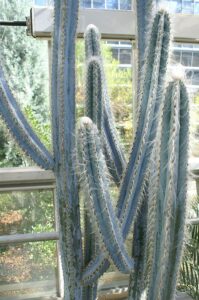Pilosocereus fulvilanatus seeds
Accepted Scientific Name:
Pilosocereus fulvilanatus
Synonyms:
Pseudopilocereus fulvilanatus, sometimes treated as a subspecies of Pilosocereus rosae
Common Names:
Commonly referred to simply as a “tree cactus”; no widely used vernacular name
Plant Origin:
Pilosocereus fulvilanatus seeds
Photo credit: David J. Stang, Creative Commons Attribution-Share Alike 4.0
Pilosocereus fulvilanatus seeds
Embark on a mesmerizing botanical journey by growing Pilosocereus fulvilanatus from seed—a striking and rare cactus species that hails from the arid landscapes of Brazil. With seeds as tiny as grains of coffee, you hold the key to cultivating a plant of architectural elegance, rich texture, and exotic allure.
Native to the dry forests, thorn scrublands, and rocky terrains of Brazil, P. fulvilanatus thrives in environments where few other plants dare to grow. These rugged habitats have sculpted the cactus into a robust survivor: resilient to intense sunlight, drought, and nutrient-poor conditions. In cultivation, the seeds promise a slow yet steady journey toward producing erect, columnar stems lined with vibrant wool and spines.
Mature specimens form profound, blue-green columns reaching up to 3 m (10 ft) tall, often branching above the base to create a dramatic silhouette reminiscent of miniature desert candelabras. Each stem sports 4–8 well-defined ribs, with areoles bearing attractive shaggy wool that ranges from red‑brown to golden and acts as natural protection while enhancing the plant’s tactile allure .
Come summer, the adult cactus produces funnel-shaped, creamy-white nocturnal flowers approximately 3.6–6 cm long. Gently fragrant, these blooms span across the hairy cephalium and allure pollinators like bats and moths. Post-pollination, globose fruits measuring 3.5–6.5 cm appear, splitting to reveal magenta-colored flesh laden with tiny seeds—each a potential future giant.
Growing from seed is deeply rewarding. For best results, sow them on a light, well-draining substrate. Press them just beneath the surface, water lightly to moisten, then cover with plastic to maintain humidity. Place them in warmth (22–28 °C / 72–82 °F) and bright, indirect light. Germination typically occurs within 2–4 weeks. Once seedlings emerge, introduce airflow gradually and then expose them to full sun, helping them develop the iconic blue‑green stem and woolly ribs.
Care is straightforward: feed with diluted cactus fertilizer during the growing season, and withhold water in winter to mimic natural dormancy . Maintain well-drained soil to avoid rot. In colder climates, overwinter your young cactus indoors near a sunny window; in warmer regions it can flourish outside year-round.
Because P. fulvilanatus is listed as Near Threatened (IUCN), propagating it from seeds plays a small but meaningful role in conserving this unique species. It’s a wonderful choice for collectors—each plant stands as a living testament to biodiversity and resilience.
